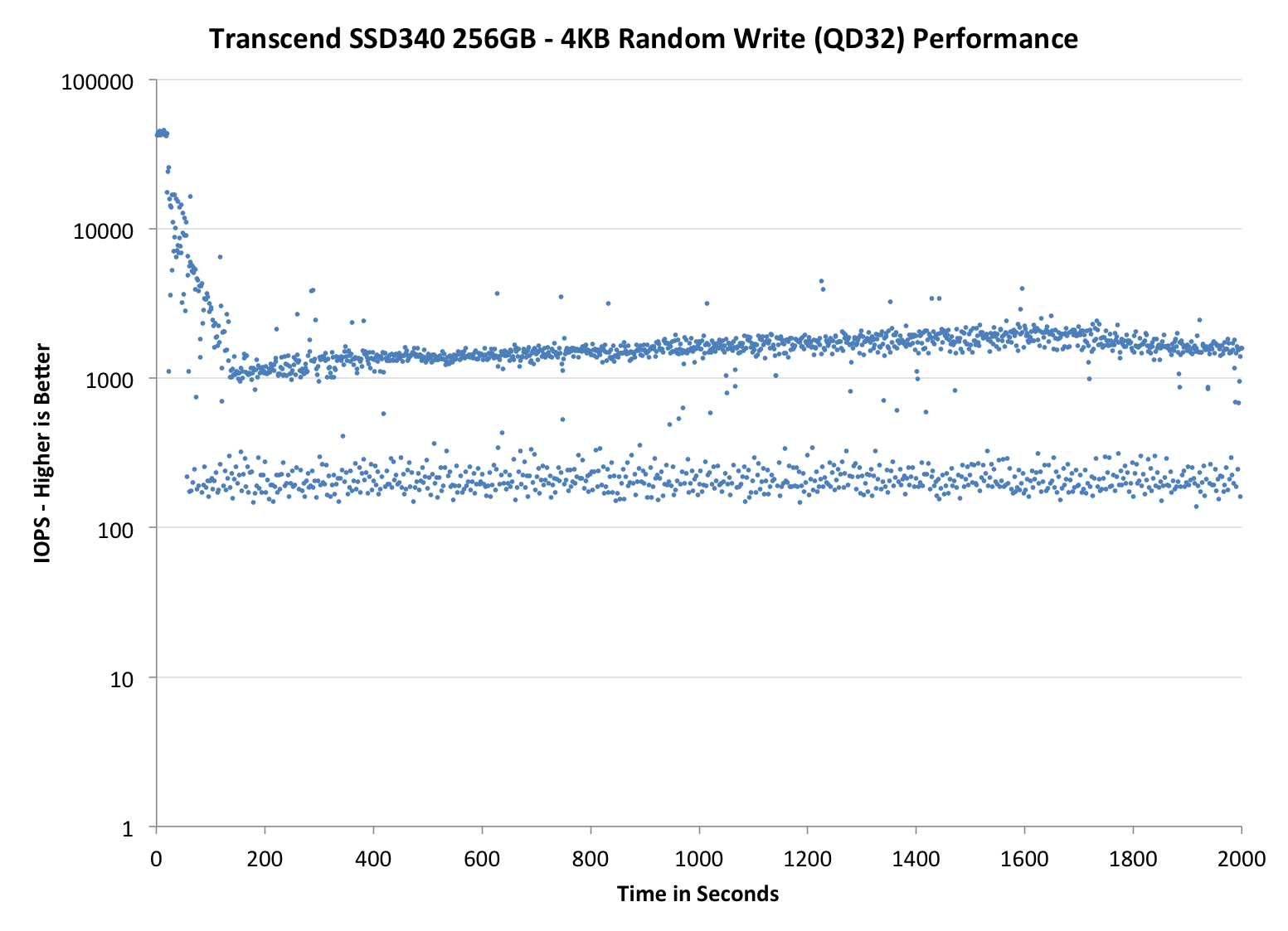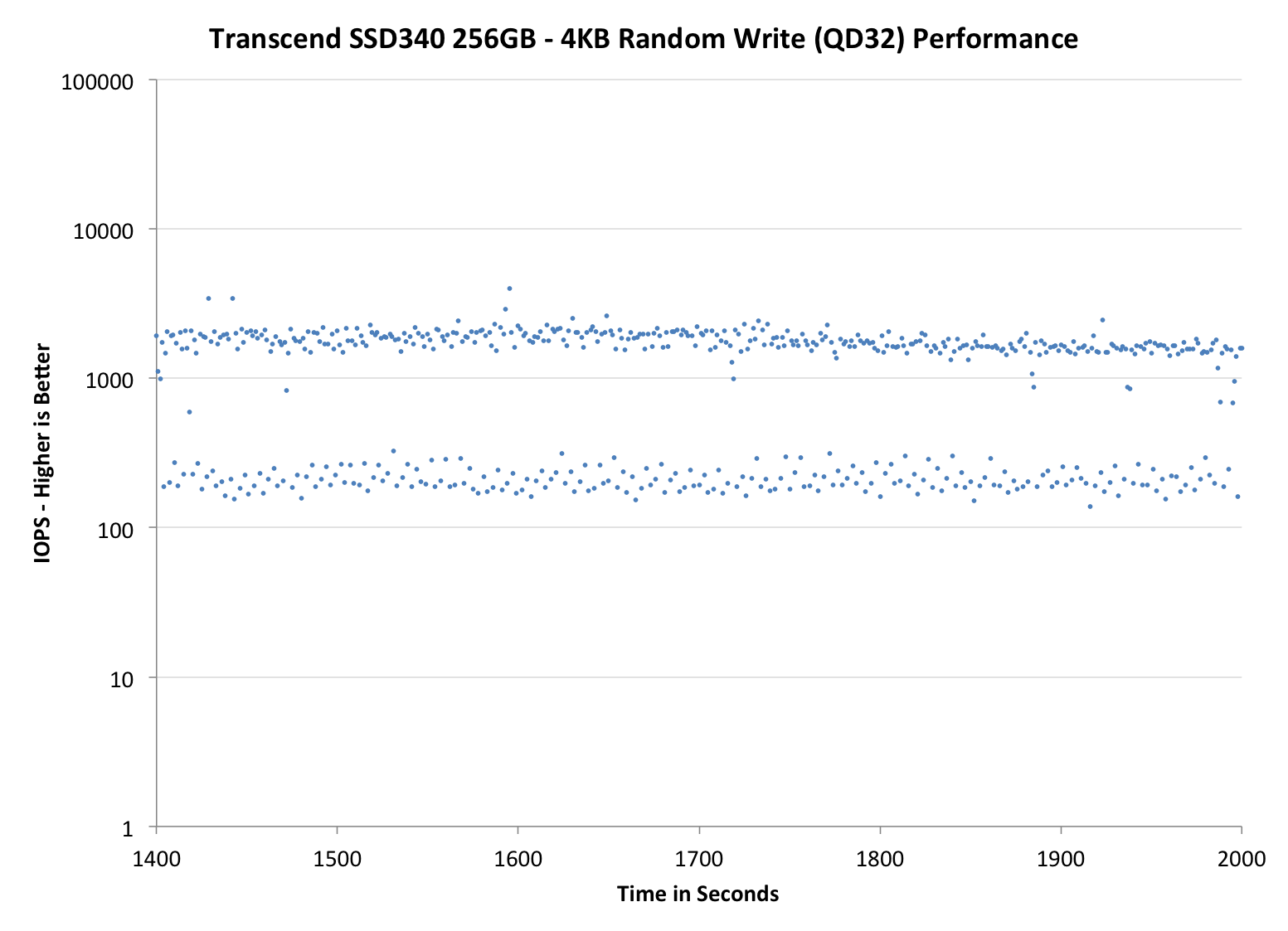Transcend SSD340 (256GB) Review
by Kristian Vättö on August 4, 2014 5:00 AM ESTPerformance Consistency
Performance consistency tells us a lot about the architecture of these SSDs and how they handle internal defragmentation. The reason we do not have consistent IO latency with SSDs is because inevitably all controllers have to do some amount of defragmentation or garbage collection in order to continue operating at high speeds. When and how an SSD decides to run its defrag or cleanup routines directly impacts the user experience as inconsistent performance results in application slowdowns.
To test IO consistency, we fill a secure erased SSD with sequential data to ensure that all user accessible LBAs have data associated with them. Next we kick off a 4KB random write workload across all LBAs at a queue depth of 32 using incompressible data. The test is run for just over half an hour and we record instantaneous IOPS every second.
We are also testing drives with added over-provisioning by limiting the LBA range. This gives us a look into the drive’s behavior with varying levels of empty space, which is frankly a more realistic approach for client workloads.
Each of the three graphs has its own purpose. The first one is of the whole duration of the test in log scale. The second and third one zoom into the beginning of steady-state operation (t=1400s) but on different scales: the second one uses log scale for easy comparison whereas the third one uses linear scale for better visualization of differences between drives. Click the buttons below each graph to switch the source data.
For more detailed description of the test and why performance consistency matters, read our original Intel SSD DC S3700 article.
 |
|||||||||
| Transcend SSD340 | JMicron JMF667H (Toshiba NAND) | JMicron JMF667H (IMFT NAND) | Samsung SSD 840 EVO mSATA | Crucial MX100 | |||||
| Default | |||||||||
| 25% OP | |||||||||
Right from the start, things do not look too promising. Compared to the reference design with the same IMFT NAND, the IO consistency is considerably lower. The reference design manages around 1,000 IOPS minimum, whereas in the SSD340 the minimum performance is around 300 IOPS. Increasing the over-provisioning helps by a bit but the consistency is still poor compared to the other value drives (like the MX100). The older firmware definitely isn't doing Transcend any favors here – quite the opposite in fact.
 |
|||||||||
| Transcend SSD340 | JMicron JMF667H (Toshiba NAND) | JMicron JMF667H (IMFT NAND) | Samsung SSD 840 EVO mSATA | Crucial MX100 | |||||
| Default | |||||||||
| 25% OP | |||||||||
 |
|||||||||
| Transcend SSD340 | JMicron JMF667H (Toshiba NAND) | JMicron JMF667H (IMFT NAND) | Samsung SSD 840 EVO mSATA | Crucial MX100 | |||||
| Default | |||||||||
| 25% OP | |||||||||
TRIM Validation
To test TRIM, I first filled all user-accessible LBAs with sequential data and continued with torturing the drive with 4KB random writes (100% LBA, QD=32) for 30 minutes. After the torture I TRIM'ed the drive (quick format in Windows 7/8) and ran HD Tach to make sure TRIM is functional.
And it is.











57 Comments
View All Comments
ddriver - Monday, August 4, 2014 - link
I didn't say "value".Impulses - Monday, August 4, 2014 - link
Besides, $30 32GB SD cards actually hit 45-60MB/s sequential.. Think I saw a $65 64GB PNY rated at 90/60 R/W, doesn't get any more value priced than that, unless you meant bargain bin SD cards...hojnikb - Tuesday, August 5, 2014 - link
Yeah, but sd card like that would be pretty unsuitable for running OS.Impulses - Tuesday, August 5, 2014 - link
Obviously, their random access speed sucks, he and I were just drawing a parallel to other cheap devices with sequential speeds that aren't very far off... Shoot, I've paid <$50 for 32-64GB USB 3.0 flash drives that hit 200MB/s sequential read/writes. I think any enthusiast knows sequential speed isn't ultimately why you buy a SSD (most of the time), but still...willis936 - Monday, August 4, 2014 - link
I'm pretty sure SSDs from 2009 are faster than this.hojnikb - Monday, August 4, 2014 - link
they are not.ddriver - Monday, August 4, 2014 - link
2-3 years ago was 2011-2012 :) I have a Samsung 830 128 GB which IRC came out around that time, and it is actually faster, reaching like 380 MB/sec in sequential reads.ddriver - Monday, August 4, 2014 - link
*writesCome on AT, what is this - the stone age? You know, the time people wrote on stone tablets and editing was pretty much impossible? How about an "edit" feature?
jabber - Monday, August 4, 2014 - link
I have to say as long as they push 150MBps+ with 0.XX access times most cases are covered.All in the access times for day to day usage, not so much the raw MBps.
hojnikb - Monday, August 4, 2014 - link
its not all about access times.You can have a bad ssd with great access times and it will still feel slow as HDD if writes are utter garbage (you can test this by installing OS on a cheap usb drive).